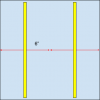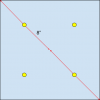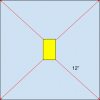wietefras
Well-Known Member
It's not that easy though. Different HPS bulbs can also have quite a different efficacy. So what is the manufacturer of the fixture going to say?
And it doesn't end at bulb efficacy. A double ended HPS bulb might be rated to produce 2100umol/s @ 1000W. Is that enough data? But then the reflector absorbs 18% of that light and only say 1750umol/s comes out of the fixture.
Now you hang this light in a 4'x4' tent. The walls are really close and the fixture needs to hang quite high. You lose a lot of light on the walls. Measurements show only 1380umols/s is then left and the walls absorbed yet another 21%. If you hang this same light in a massive green house the walls are so far away from most lights that wall losses are inconsequential. So the full 1750umol/s would apply for all but the outer ring of lights.
What umol number out of all of these should they use? It's a fixture that can run a 1000W HPS bulb though. So that's what goes on the box.
So you could argue to just report the 1750umol/s figure, but In actuality you could also alter the reflector. Some reflectors will lose 30% of the light. So the fixture would then only produce 1470umol/s. When the reflector gets dirty it quickly absorbs more light too.
The permutations pretty much never end.
With leds you normally do not see reflectors applied, but the wall losses are still there. A fixture that hangs twice as high will end up lighting twice the amount of wall. Which means you will also lose about twice the amount of light on the walls.
So it's not just the efficacy that you need to keep in mind.
The hanging height is determined solely by the light distribution you wish to achieve. Think of shining a flashlight straight down on the floor. If it's close to the ground you will see a small circle. When you lift the light up the circle gets bigger. An led fixture is basically a lot of tiny flashlights shining down and you must lift them high enough so their light overlaps and shows a uniform light intensity.
So if you compare 2 lights the hanging height becomes an important factor too since it multiplies the wall losses.
The hanging height with 120 beam angle led should be at least the same as the radius of the circle you want it to light up (with that 120 beam angle).
So if you have 1 light over 1x1 then the maximum distance would be from the center to the corner making the distance which would be the square root of (6"^2 + 6"^) = 8.5". For a single COB the minimum hanging height over a 1x1 area would be about 8" (taking into account the size of the COB).
If you hang a led strips that go from wall to wall, the maximum distance would be the heart to heart distance from strip to strip. So say you put a led strip over a 1 foot wide area, you'd only have to hang it at 6" height to cover at the same uniformity as that COB at 8"
Now if you hang a QB you generally hang one over a 2x2 area. The bit covered with leds is about 10.5"x5.5" which means that in the corners you need to cover a bit that's (24-10.5)/2=6.75" by (24-5.5)/2=9.25. Pythagoras tells us that this distance to the corners is then sqrt(6.75^2 + 9.25"^2)=11.5". And then probably a bit higher since the clump of light in the middle will give too much of a hotspot otherwise. Say 12" at least, but probably more.
So 2 led strips covering a 2x2 tent would need to be at 6" minimum height
4 COBs covering the same 2x2 tent at 8"
1 QB also covering 2x would need to be at 12".
Resulting in double the wall losses for the QB compared to 2 led strips. That's why the professional lights coming out now are all ledstrip (led bar) based. Growcraft X6, Zeus 600WPro, Gavita 1700e, Fluence Spydr etc etc. These are massive 40"x40" fixtures spreading out the light by spreading the light point uniformly over the space. Rather than clumping all the light in the middle of the tent and then let a higher hanging height spread the light.



Same goes with full fixtures. A 40"x40" 650W fixture (or 1700umol/s output) will spread it's light much more uniformly than a 20"x20" fixture with the same output.
If you want to build something yourself look into Samsung or Bridgelux led strips. They come in 2 and 4 foot lengths. Attach them to an aluminium U extrusion as heat sink.
And it doesn't end at bulb efficacy. A double ended HPS bulb might be rated to produce 2100umol/s @ 1000W. Is that enough data? But then the reflector absorbs 18% of that light and only say 1750umol/s comes out of the fixture.
Now you hang this light in a 4'x4' tent. The walls are really close and the fixture needs to hang quite high. You lose a lot of light on the walls. Measurements show only 1380umols/s is then left and the walls absorbed yet another 21%. If you hang this same light in a massive green house the walls are so far away from most lights that wall losses are inconsequential. So the full 1750umol/s would apply for all but the outer ring of lights.
What umol number out of all of these should they use? It's a fixture that can run a 1000W HPS bulb though. So that's what goes on the box.
So you could argue to just report the 1750umol/s figure, but In actuality you could also alter the reflector. Some reflectors will lose 30% of the light. So the fixture would then only produce 1470umol/s. When the reflector gets dirty it quickly absorbs more light too.
The permutations pretty much never end.
With leds you normally do not see reflectors applied, but the wall losses are still there. A fixture that hangs twice as high will end up lighting twice the amount of wall. Which means you will also lose about twice the amount of light on the walls.
So it's not just the efficacy that you need to keep in mind.
The hanging height is determined solely by the light distribution you wish to achieve. Think of shining a flashlight straight down on the floor. If it's close to the ground you will see a small circle. When you lift the light up the circle gets bigger. An led fixture is basically a lot of tiny flashlights shining down and you must lift them high enough so their light overlaps and shows a uniform light intensity.
So if you compare 2 lights the hanging height becomes an important factor too since it multiplies the wall losses.
The hanging height with 120 beam angle led should be at least the same as the radius of the circle you want it to light up (with that 120 beam angle).
So if you have 1 light over 1x1 then the maximum distance would be from the center to the corner making the distance which would be the square root of (6"^2 + 6"^) = 8.5". For a single COB the minimum hanging height over a 1x1 area would be about 8" (taking into account the size of the COB).
If you hang a led strips that go from wall to wall, the maximum distance would be the heart to heart distance from strip to strip. So say you put a led strip over a 1 foot wide area, you'd only have to hang it at 6" height to cover at the same uniformity as that COB at 8"
Now if you hang a QB you generally hang one over a 2x2 area. The bit covered with leds is about 10.5"x5.5" which means that in the corners you need to cover a bit that's (24-10.5)/2=6.75" by (24-5.5)/2=9.25. Pythagoras tells us that this distance to the corners is then sqrt(6.75^2 + 9.25"^2)=11.5". And then probably a bit higher since the clump of light in the middle will give too much of a hotspot otherwise. Say 12" at least, but probably more.
So 2 led strips covering a 2x2 tent would need to be at 6" minimum height
4 COBs covering the same 2x2 tent at 8"
1 QB also covering 2x would need to be at 12".
Resulting in double the wall losses for the QB compared to 2 led strips. That's why the professional lights coming out now are all ledstrip (led bar) based. Growcraft X6, Zeus 600WPro, Gavita 1700e, Fluence Spydr etc etc. These are massive 40"x40" fixtures spreading out the light by spreading the light point uniformly over the space. Rather than clumping all the light in the middle of the tent and then let a higher hanging height spread the light.



Same goes with full fixtures. A 40"x40" 650W fixture (or 1700umol/s output) will spread it's light much more uniformly than a 20"x20" fixture with the same output.
If you want to build something yourself look into Samsung or Bridgelux led strips. They come in 2 and 4 foot lengths. Attach them to an aluminium U extrusion as heat sink.





